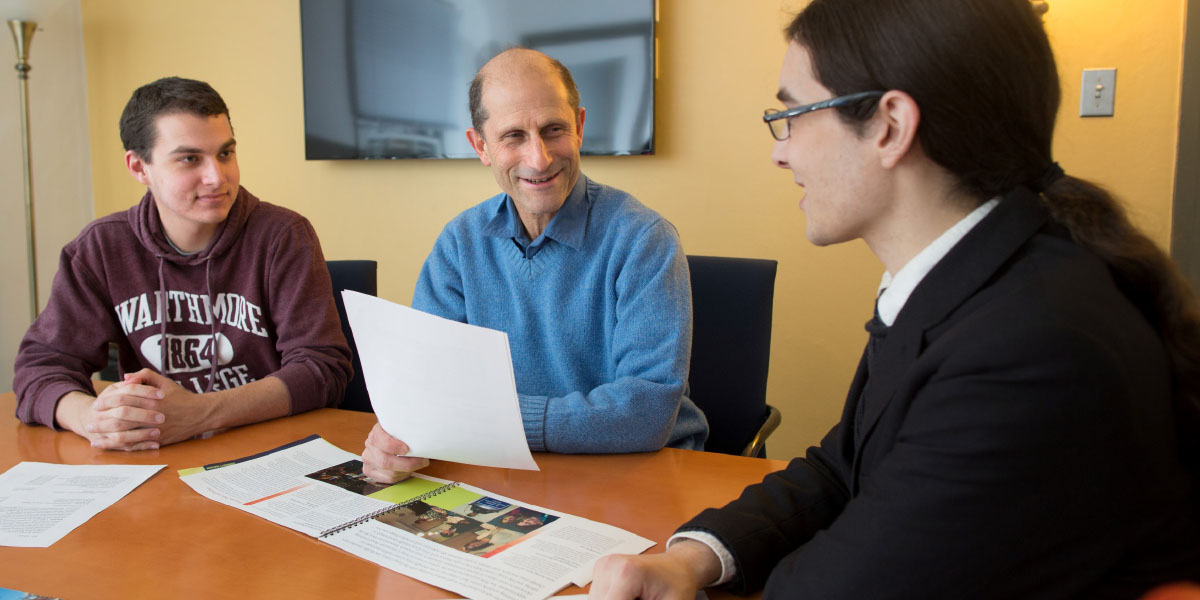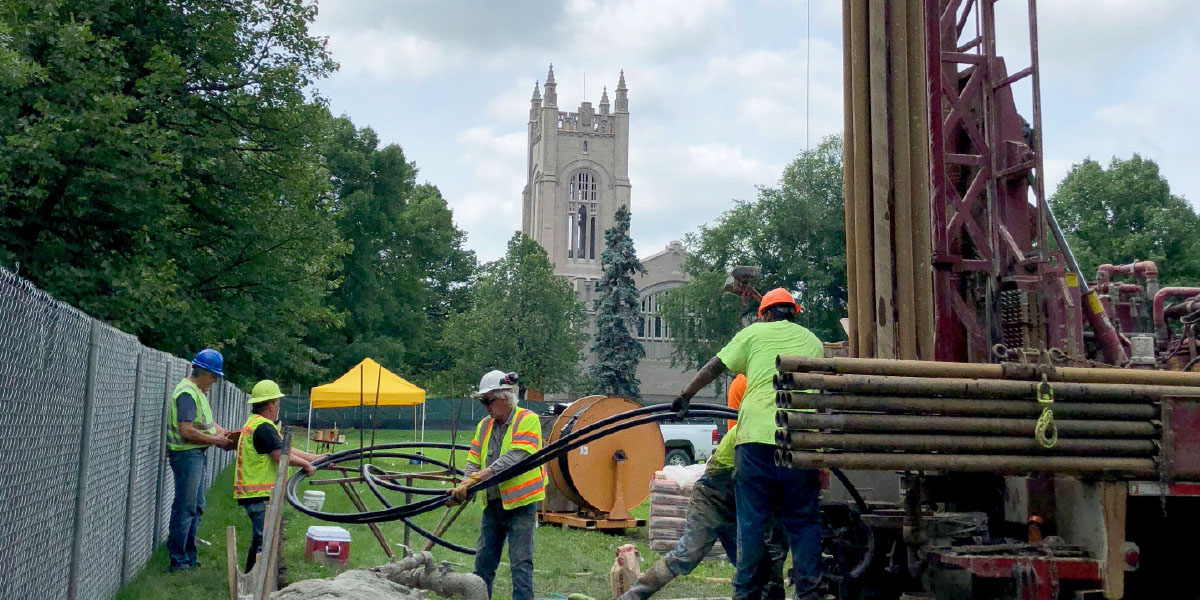NACUBO honored two institutions―Swarthmore College, Swarthmore, Pa., and Carleton College, Northfield, Minn.―with its 2019 Excellence in Sustainability Award. The award recognizes institutions that have demonstrated excellence and innovation in sustainability leadership.
This year’s competition had a new and important twist, says Sally Grans Korsh, NACUBO senior advisor of facilities management and environmental policy. “While many campuses are engaging in excellent sustainability efforts, the focus this year was on a particular and specific process, project, or activity,” she says. “The judges reviewed 19 submissions, all of which had great merit, but when evaluated against the criteria, these two institutions emerged.” Business Officer interviewed representatives from both campuses to learn more about their campuswide plans.
The Price of Carbon

Swarthmore College is a pioneer in carbon pricing, with a goal of achieving carbon neutrality by 2035. Its carbon charge program creates an internal price on carbon emissions, which generates about $340,000 a year for Swarthmore’s Green Revolving Loan Fund, as well as campus utility planning, renewable energy, metering upgrades, and educational programming.
Swarthmore instituted a carbon emissions fee in 2016 “to keep fossil fuel in the ground and to support the kind of change required for humanity to thrive in the future,” says Aurora Winslade, the school’s sustainability director. “Carbon pricing is an important part of the sustainability solution, and our role in society as a higher education institution is to be a thought leader and provide solutions to the public and policymakers.”
The institution charges departments—based on the size of their operating budgets—a direct fee of $40 per ton of carbon emmissions, as well as a shadow price of $100 per ton for new construction or major renovations.
“As part of the carbon charge program, every office and department pays a percentage of its budget to help fund sustainability projects,” says Gregory Brown, vice president for finance and administration. “We were concerned about implementing that amid the numerous other pressing needs across the college, but the campus community quickly embraced the concept, and, in fact, some departments contribute additional funds.”
How do some departments make extra contributions to the carbon charge program?
Winslade: Members of the admissions department, for example, instituted a pilot program to reduce their impact on the environment by reducing department-related travel. They decided to rely more on video conferencing for their meetings and even wrote a letter to high school guidance counselors explaining the impetus for this change. The year that this change was implemented, the number of applications actually increased, so they upgraded their software to better facilitate long-distance meetings and also voluntarily contributed additional funds.
Have there been any complaints?
Winslade: There were some complaints in the beginning, but I saw that criticism as an opportunity for dialogue. Most people care about the environment and want to do their part to help protect it. Explaining that the money, about $340,000 annually, would be used in constructive, verifiable, and measurable ways to reduce greenhouse gas emissions helped convince the skeptics.
Who decides how the money is spent?
Winslade: The carbon charge committee—which is a group of faculty, staff, and students—decides how to distribute the funds.
Why did you decide to base the fee on department budget size?
Winslade: We are using budget size as a proxy. It’s certainly fair to say that our fee is imperfect. We don’t have perfect metering, so it’s not feasible for us to say exactly what emissions an individual department is responsible for. But we believe that “good” is better than not doing anything at all.
How does the shadow price work?
Winslade: Essentially, it is a decision-making tool. Our faculty members, who originally came up with the idea to implement campus carbon pricing, believe it is important to look not only at first costs when investing in a capital project but also to look at the full life-cycle impact of that decision. For any capital project with significant greenhouse gas implications, we do life-cycle cost analysis.
Before implementing this tax, what discussions did you have with other institutions?
Winslade: We had extensive conversations with the sustainability coordinator for Vassar College, Poughkeepsie, N.Y., who had put out a white paper on carbon pricing, and with Yale University, New Haven, Conn., which has implemented a very sophisticated direct fee on carbon emissions on a building-by-building, department-by-department basis.
There are multiple pathways for higher ed to implement carbon pricing. As educators, we need to show people what carbon pricing is, how it works, and the impact it can have. We need to back up our advocacy work with real action.
Where should institutions that are interested in carbon pricing start?
Winslade: They can start with the Internal Carbon Pricing in Higher Education Toolkit, a resource recently released by the Carbon Pricing in Higher Education Working Group, of which Swarthmore is a member. The free toolkit provides case studies, sample communications, calculator tools, and research papers.
Why did you become a proponent of the carbon charge program, knowing it would create more work for the business office?
Brown: The carbon charge program is a reflection of a core tenet of our mission at Swarthmore: Developing in our students a deep sense of ethical and social concern. Climate change is among the most significant challenges we face as a society, and through our conversations with faculty and staff, we developed this program to help address issues of sustainability on campus while also educating the broader campus community.
What lies ahead for Swarthmore’s carbon pricing program and any other environmental initiatives?
Brown: We are continuing to review and assess the carbon charge program, and we hope to evolve it to more directly influence behaviors such as air travel and temperature controls.
Winslade: We believe a national price on carbon is coming and that exploring carbon charging on the campus level is the right and the fiscally responsible thing to do to prepare for the future. We are also looking to the future by creating an energy infrastructure master plan, looking at both a 30- and 50-year time horizon for our campus energy system.
Transitioning to Geothermal

Carleton College is transforming the energy profile of its campus with its utility master plan. Through initiatives that include the transition of its 100-year-old steam system to hot water heating from a centralized ground source geothermal heat pump system, the college anticipates a 40 percent reduction in central plant energy use and a sizable reduction in carbon emissions, among other benefits.
After years of data gathering and analysis, Carleton College’s transition to geothermal began in earnest when it was faced with an aging and outdated central facilities plant and steam distribution system. The new geothermal heat pump system will provide 70 percent of the college’s annual heating and cooling needs, while supplementing peak demands with high-efficiency condensing boilers in the winter and existing electric chillers in the summer. To facilitate this change, all existing steam equipment and distribution piping is transitioning to hot water, with the east side of campus having been completed in summer 2019.
Fred Rogers, vice president and treasurer of Carleton College; Martha Larson, manager of campus energy and sustainability; and Steve Spehn, director of facilities and capital planning, concur that this hybrid solution meets three of the school’s primary goals: addressing deferred maintenance per the strategic plan, providing for the utility loads of planned new construction, and reducing operating costs and carbon emissions.
Did you evaluate other renewable energy sources before deciding upon geothermal?
Larson: Yes, we explored a couple of other heating strategies and spent some time looking into biomass. Biomass came with certain challenges, including obtaining, storing, and handling the biomass material. During peak heating season, we would need to burn up to eight semis of organic material a day, and we realized that would add significant complexity to our plant operation and maintenance.
Eventually, it became apparent that geothermal could solve the problem of how to heat the campus sustainably without increasing our operating costs. By transitioning to geothermal, we will drastically reduce our dependence on natural gas but increase our use of electricity.
Rogers: We sometimes refer to it as our “bet on electricity.” As the public electricity grid becomes greener, our campus carbon emissions will decrease accordingly.
What convinced you that geothermal would work for your campus?
Spehn: Our chapel, which was due for renovation, operated on a steam system that needed to be replaced. We looked at renovating it to a hot water system using 120-degree water, which is the same temperature that a geothermal system would use. There was some question as to whether 120-degree water would heat a building adequately because most campus radiators operate at 160 to 180 degrees. Even in our cold climate, the 120-degree water worked well for the chapel pilot project, which gave us confidence the geothermal system would also succeed.
What is the college’s timeline for completing the process of transitioning to geothermal?
Larson: Our initial concept discussion with our engineering design firm was in summer 2013. Our chapel pilot project occurred in 2015. We broke ground on Phase 1—transitioning the whole east side of campus to low temperature hot water and geothermal—in summer 2017. We plan to complete the west campus tie-in by fall 2021.
What processes did you use to engage Carleton’s stakeholders in the plan and its progress, and how have you kept them engaged?
Larson: We have used various communication channels, including a project website, live Facebook streams, press releases, art displays highlighting activities in the field, and signage that promotes project fun facts.
We have tried to make the process interesting for everyone. We brought earplugs and granola bars to the dorms on the days the drillers started early. We sponsored Well Field Wednesdays, which were live Facebook feeds during the first summer of drilling the well fields. When we turned off the east campus steam for the last time, we held an ice cream social.
Rogers: We have also kept the data and project information publicly available to the campus so faculty and students can stay involved through their classes.
Larson: A variety of disciplines have used this project as a teaching tool. For example, geology classes tested soil samples from sites on campus where the wells were being drilled, and an environmental ethics class evaluated the question: Should usable equipment be replaced by a new system that is better for the environment?
Did you get any pushback?
Rogers: As we went through this process, we got a lot of questions which, after doing our due diligence of looking into alternatives, eventually led to enthusiastic support. We were very careful to ask, “If we don’t do this, what do we do instead?” The alternative to geothermal would have meant the money earmarked for upgrades and potential expansion to our existing steam heating plant would have been committed for the next 40 to 50 years to steam. People understood that the geothermal option was better environmentally, and that in less than 20 years the savings in operations costs from the hybrid option would probably pay for the difference in ongoing maintenance of the aging steam system.
What advice do you have for other institutions, and for business officers specifically, that are revisiting their campus energy plans?
Spehn: Somebody on campus needs to understand how the heating and cooling systems currently operate and be able to provide utility and usage data so the selected system can be properly assessed and sized.
Rogers: First, begin where you are. At Carleton, we started with LED lighting changes and improving insulation and steam traps. We viewed maintenance expenditures as an ongoing opportunity to improve efficiencies and reduce carbon, eventually installing two wind turbines. These were a tremendous base that we’ve built on further.
Secondly, stay focused on your long-term goals—on what you really want to accomplish. Compromises will come, and with creative analysis and dialogue you will find good alternative paths. If you focus only on what seems possible from the beginning, you won’t meet your potential because it is hard to incrementally work up to what you might have accomplished if you had started from the higher goals first and worked back.
Finally, be patient, collect data, take a multiyear perspective, and listen to input from your staff, consultants, board, and other stakeholders. Our project did not end up where we first envisioned it would.
MARGO VANOVER PORTER, Locust Grove, Va., covers higher education business issues for Business Officer.



